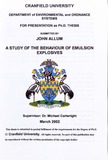JavaScript is disabled for your browser. Some features of this site may not work without it.
| dc.contributor.advisor | Cartwright, M. | |
| dc.contributor.author | Allum, J. | |
| dc.date.accessioned | 2009-11-17T18:31:51Z | |
| dc.date.available | 2009-11-17T18:31:51Z | |
| dc.date.issued | 2009-11-17T18:31:51Z | |
| dc.identifier.uri | http://hdl.handle.net/1826/3976 | |
| dc.description.abstract | This study investigated the formulation and characterisation of emulsion explosives. This included the manufacture of more than 120kg of emulsion explosive of which around 105kg was used on the explosive ordnance range in over 350 individual firings. For each emulsion composition, an average of eight firings was undertaken with which to substantiate the explosive performance data. The formulation was varied to determine the effects of water content upon the physical characteristics of the emulsion. These physical effects included thermal conductivity, particle size, viscosity and the explosive performance of the emulsion. In respect of explosive performance, microballoons were added to sensitise the emulsion and the proportions of microballoons added were altered to look at their effect on velocity of detonation, sensitivity and the brisance of the emulsions. Emulsion explosives are commonly referred, in literature, as Type 11 non-ideal explosives. This is due to their non-linear behaviour with respect to the variation of velocity of detonation with density. Traditionally, when an emulsion explosive was commercially manufactured, the water content has been kept at a minimum (12-17%). This was accepted as the way to achieve the best explosive performance, based upon the belief that an emulsion with the highest concentration of active ingredients, ammonium nitrate and oil, would give the best explosive performance. This study examined a wider range of emulsion explosive water contents than has been previously studied, from 12% to 35% water. It was found, during this study, that higher water content emulsions, specifically 25% water, had a marked increase in explosive performance. The highest velocity of detonation recorded was in a 39mm diameter tube, at 25% water content with 3% microballoons, was 5558ms-1. This was some 15% higher than any other VOD recorded in this study. The high velocity of detonation, at 25% water content, was one of a number of physical characteristics in which this water content varied from the other emulsion water contents. This study endeavored to show that emulsion explosives could exhibit two differing types of explosive reaction, thermal explosion and grain burning. This was based on the velocity of detonation and plate dent data, both of which indicated that there was a change in reaction with water content. Emulsion explosives, with a high water and high microballoon content, exhibited a thermal explosion type reaction. They exhibited Type I ideal explosive behaviour, with increasing velocity of detonation with density. Lower water content emulsion explosives, displayed the more commonly expected Type 11 non-ideal behaviour and reacted in a grain burning type detonation. | en_UK |
| dc.language.iso | en | en_UK |
| dc.subject | Emulsion explosives | en_UK |
| dc.subject | Explosive properties | en_UK |
| dc.subject | Initiation | en_UK |
| dc.subject | Detonation | en_UK |
| dc.title | A Study of the behaviour of emulsion explosives | en_UK |
| dc.title.alternative | Department of Environmental and Ordnance Systems | en_UK |
| dc.type | Thesis or dissertation | en_UK |
| dc.type.qualificationlevel | Doctoral | en_UK |
| dc.type.qualificationname | PhD | en_UK |
